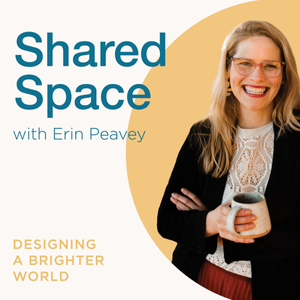
Shared Space
Erin Peavey
All episodes
Best episodes
Seasons
Top 10 Shared Space Episodes
Goodpods has curated a list of the 10 best Shared Space episodes, ranked by the number of listens and likes each episode have garnered from our listeners. If you are listening to Shared Space for the first time, there's no better place to start than with one of these standout episodes. If you are a fan of the show, vote for your favorite Shared Space episode by adding your comments to the episode page.
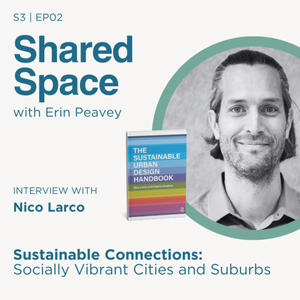
02/11/25 • 44 min
Nico Larco is a visionary leader and changemaker at the intersection of architecture, urban design, and sustainable development.
As a Professor of Architecture at the University of Oregon, Director of the Urbanism Next Center, and Co-Founder and Co-Director of the Sustainable Cities Initiative, Nico has dedicated his career to designing environments that inspire human connection, improve our collective well-being, and contribute to a healthier planet.
His unique blend of expertise, spanning cognitive psychology, architecture, urban planning, and international sustainability work, fuels his ability to see beyond conventional boundaries.
With numerous national and international accolades under his belt, Nico’s impact resonates far beyond his immediate academic circle. He takes complex challenges, like balancing housing needs, social equity, and environmental resilience; and translates them into actionable strategies for livable density, walkable neighborhoods, and vibrant, human-centered public spaces.
His recent co-authored book, The Sustainable Urban Design Framework, equips stakeholders with the insights needed to respond to complex challenges and build truly sustainable communities.
Whether collaborating with public agencies, private developers, nonprofits, or students, Nico consistently models a spirit of partnership, understanding that transformative change only emerges when everyone’s voice is at the table.
Nico Larco’s vision reframes the conversation around our cities. By placing people, relationships, and environmental resilience at the heart of architectural and urban design decisions, he reminds us that the spaces we shape ultimately shape us, guiding us all toward more vibrant, caring, and sustainable futures.
Key Takeaways
1. Design for People First - Our built environment should be shaped around human needs, fostering interaction, well-being, and genuine connection.
2. Unlock Suburban Potential - Even in car-oriented suburbs, small tweaks; like adding walking paths or creating inviting public spaces, can spark a vibrant community life.
3. Value the Power of Density - Thoughtful, human-scale density can support walkability, reduce car-dependence, and bring neighbors closer together.
4. Embrace Active, Lively Streets - When buildings and businesses engage directly with sidewalks and public spaces, communities bloom with social activity and a sense of belonging.
5. Collaborate Across Boundaries - Progress happens when designers, policymakers, community members, and industry leaders join forces, share ideas, and solve problems as one.
6. Rethink Sustainability Holistically - True sustainability isn’t just about energy savings, it’s about health, equity, resilience, and helping people truly thrive.
7. Start Small and Go Big - Even the simplest interventions; like reorienting a storefront, creating a bike path, or adding seating, can spark transformative change and inspire others to reimagine their neighborhoods.
Quotes
1. “The urban condition is not a physical thing, it’s a social thing. It’s absolutely about interaction—seeing people, interacting with people, and recognizing that’s where everything happens.”
2. “It’s not rocket science—just think about connections early on. Even creating a simple pedestrian path can transform how people move, interact, and build community.”
3. “We’re not just aiming for aesthetics; we need to make places that really work for people—places where everyday life becomes easier, more vibrant, and naturally more social.”
Connect with Nico
Linkedin -https://www.linkedin.com/in/nico-larco-6702a213/
Website -https://www.urbanismnext.org/
Instagram -https://www.instagram.com/sustainable.urban.design/
Book -https://www.amazon.com/Sustainable-Urban-Design-Handbook/dp/1138945676
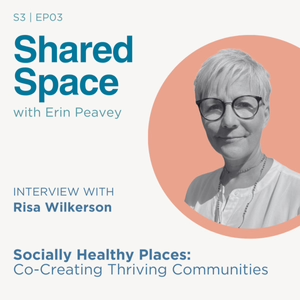
02/25/25 • 36 min
Risa Wilkerson is a pioneer in the field of community health and design, dedicated to creating spaces that foster connection, inclusivity, and well-being.
As the Executive Director of Healthy Places by Design, Risa has spent nearly two decades working at the intersection of public health, community development, and equity.
Her work empowers organizations across the U.S. to design environments that bring people together, breaking down barriers to create stronger, more resilient communities.
Risa’s passion for this work stems from her own experiences growing up in a rural, close-knit community, where she first began to understand the power of place and connection.
Her journey has taken her from rural America to urban centers and across the country, gaining invaluable insights into how thoughtful, human-centered design can make a profound difference in people’s lives. Whether living in a co-housing community, a van, or a sailboat, Risa has continually sought spaces that allow for greater connection with others, finding that the most vibrant communities are those that provide access to shared public spaces and offer a sense of belonging.
Erin Peavey and Risa Wilkerson are co-authors and co-chairs of the Systems of Cross-sector Integration and Action across the Lifespan (SOCIAL) Framework Report on the Built Environment. Risa advocates for the importance of creating spaces that bring people together, fostering both "weak" and "bonding" ties that are essential for individual and collective well-being.
Her deep commitment to social justice and equity drives her work, ensuring that the voices of historically marginalized groups are heard and included in the design process.
Through her work with Healthy Places by Design, Risa has become a leading voice in advocating for spaces that nurture relationships, embrace diversity, and promote joy.
Her dedication to building communities where people feel seen, heard, and valued is not just professional - it’s personal.
Key Takeaways
1. Design for Connection - The spaces we create have the power to foster deep connections. When we design with community in mind, we build environments that bring people together, spark joy, and reduce isolation.
2. Co-Create with the Community - True connection comes from collaboration. Involve the community in the design process to ensure spaces meet their needs and reflect their values, creating a sense of ownership and belonging.
3. The Power of Third Places - Third places (public spaces outside of home and work) are crucial for building community. Coffee shops, parks, and community centers can be the places where connections thrive.
4. Safety and Accessibility Are Key - To foster connection, we must prioritize safety, accessibility, and proximity. Design spaces that allow people to feel comfortable and open to engaging with others.
5. Engage the Young Generation - Don’t forget to include youth in the design process. By involving the next generation in shaping their environments, we can create spaces that empower and inspire them to lead.
6. Honor History, Celebrate Culture - Every community has a rich history. Incorporate cultural and historical elements into the design of spaces to honor the past while creating a sense of pride and continuity for the future.
Quotes
1. "We have to ask, who in our community isn’t being heard? Those are the voices we need to bring to the table to create spaces where everyone feels welcome." – Risa Wilkerson
2. "When we design with the community, we create spaces where people not only feel safe, but they feel seen, valued, and ready to connect." – Risa Wilkerson
3. "Third spaces—places where people gather outside of work or home—are the heart of a connected community. Let’s create those spaces where bonds can form and thrive." – Risa Wilkerson
Connect with Risa
Linkedin - https://www.linkedin.com/in/risawilkerson/
Website - https://healthyplacesbydesign.org/
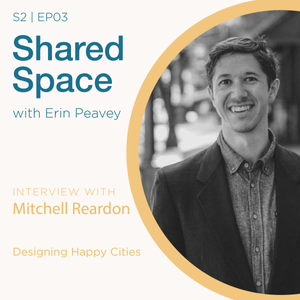
Designing Happy Cities with Mitchell Reardon
Shared Space
03/09/21 • 30 min
Can our cities be designed to make us happier? What is the role of public space in fostering a more civil society? Can street design foster trust – or even romance?
Mitchell Reardon, a senior urban planner, lecturer, and leader at Happy Cities. Happy Cities is an interdisciplinary firm working at the intersection of urban design, policy, engagement and human wellbeing. They turn evidence into action for happier, healthier and more inclusive communities.
Mitchell’s experiments, projects and research have helped clients achieve high standards in health, wellbeing and sociability in cities around the world, including Vancouver, Wuhan, Mexico City and Stockholm. Mitchell co-founded Metropolitan Collective, a group of tactical urbanists who have transformed unloved and overlooked spaces in Vancouver and beyond. He is a board member for the Vancouver Public Space Network. Mitchell is a compelling lecturer whose paradigm-shifting keynotes on the link between urban design, sustainable planning and human health have moved audiences in Canada and in Europe.
Mitchell received his Masters of Science in Urban and Regional Planning at Stockholm University in Sweden. His work and insights have been published or broadcast on Next City, CBC News, StarMetro, CBC Radio and more.
In this episode we talk about:
How snow boarding shaped how his lens on design
Why design for social well-being matters
Measuring the impact of interventions
How to create an inclusive process
The role of policy is making happy, healthy design a reality
Why and how to connect with local communities
![Shared Space - The Psychology of Places of Connection with Dr. Colin Ellard [Part 1 of 2]](https://storage.googleapis.com/goodpods-images-bucket/episode_images/3cffcbf3d01d9641ad1df1d761ad83ff8f55bf96eae5452eef468d2af9ec0847.avif)
07/13/20 • 37 min
I speak with acclaimed author, researcher, TEDx speaker, and professor of environmental psychology, Dr. Colin Ellard.
Part 1: On this first part of our two-part episode, Colin and I explore how he discovered his passion for this field, how COVID-19 is shaping his current research and how we are all connecting, and lastly we discuss what evolutionary psychology can teach us about ideal group sizes for connection and community.
Part 2: On the second half of our two-part episode, Colin and I explore research around what small tweaks can shape how we evaluate and want to connect with others, difference between what people think will make them happy and what they want, vs. what actually makes us happy in our home environments, and lastly he leaves us with what he hopes we consider in design and beyond.
Referenced in the show: Colin Ellard's website; University of Waterloo’s Urban Realities Lab
Colin's most recent book, Places of the Heart
Dunbar's Number, Ideal Group Sizes - Research; Popular Press
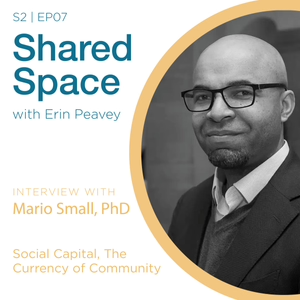
05/04/21 • 40 min
Dr. Mario Luis Small grew up in Panama City, the son of an architect in a tight knit community of other families. He learned first-hand the way that spaces and social connections shape well-being and community.
In this episode of Shared Space, I talk with Mario, Grafstein Family Professor in the Department of Sociology at Harvard University, about how his early experiences shaped his future work and his discovery around the importance of social capital, trust and social ties in strengthening communities across the globe, and specifically the nature of architecture and urban design to shape connection.
Dr. Small has published award-winning articles, edited volumes, and books on topics such as social relationships, urban poverty, and the relationship between qualitative and quantitative methods. He has amazing books, from Villa Victoria to Unanticipated Gains, to his latest book, Someone To Talk To: How Networks Matter in Practice.
In this episode, we discuss...
- Introduction [0:30]
- A Place of Connection for Him Growing Up [02:56]
- What are Social Capital and Social Ties, and Why They are Important [05:47]
- Bridging versus Bonding Ties [07:57]
- How Social Ties Impact Our Health and Overall Well-being [09:25]
- Self-Care versus Caring for Others [14:43]
- How Nature of our Social Connections Changed During the Pandemic [18:08]
- Do Fewer Connections Mean Deeper Connections? [24:27]
- Places where He Feels the Environment Has Impacted the Connections of Communities [26:45]
- Networking of Mothers at Childcare Centers [31:20]
- How Things are Different for Communities of Lower Socioeconomic Status [32:54]
- What He Wishes Designers Would Consider When Designing for Social Connection [35:48]
- Closing Remarks [38:33]
Where to Find Dr. Mario Luis Small
Twitter: @MarioLuisSmall
Website: http://www.marioluissmall.com/
Resources Mentioned
Loneliness: Human Nature and the Need for Social Connection by John T. Cacioppo and William Patrick
About the Host
Erin is an architect and design researcher bridging the gap between research and practice with a focus on design for health. She believes in the power of places to heal, connect, and serve vulnerable people — from hospital patients and staff, to people struggling with social isolation and mental health challenges. Erin is driven by a commitment to help others and the joy of working together to solve complex problems with shared purpose.
Twitter: @erin_peavey; LinkedIn: Erin K. Peavey; Instagram: @design.for.health
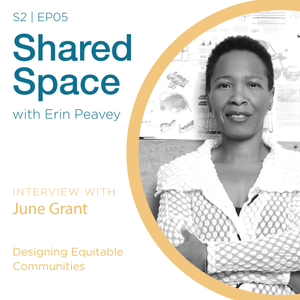
Designing Equitable Communities with June Grant
Shared Space
04/06/21 • 32 min
June Grant is an architect, designer and researcher committed to the craft of buildings, their potential to enhance cities and develop socially responsible solutions to complex real-world problems. She is the founding Principal of blink!LAB architecture, a boutique, research-based architecture practice focused on adaptive and transformative sustainable development. June has a master’s in architecture from Yale and has studied economics and sculpture. She is the immediate-past President of the San Francisco Chapter of the National Organization of Minority Architects (SFNOMA), where she is committed to growing practice opportunities for under-represented groups by strengthening the role of communication. June is a community builder in every sense of the word.
In this episode, June shares:
- Her memories growing up in Jamaica and how they shaped her journey to be an architect.
- The strength and joy of intergenerational living.
- How AARP – the largest nonprofit organization dedicated to older adults – found her work and wanted to partner.
- How “granny flats” (i.e., accessory dwelling units (ADUs), in-law units) can help support diverse, sustainable, and equitable communities.
- The power of observation as critical to design and community building.
To learn more, visit our website at erinpeavey.com/sharedspace
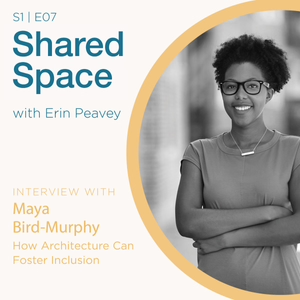
08/04/20 • 46 min
In this episode, Maya and I explore how architecture can help create community and foster inclusion – how often it’s purposefully designed to exclude and how we can change that. Maya’s journey to create Chicago Mobile Makers started off with two questions - 1. How can we diversity the design profession? 2. How can we improve disinvested communities? And, can those two things happen simultaneously?
Maya believes that architecture should not be a privilege and must expand to accommodate more people through teaching and community engagement. While working full time and completing her master's, she founded Chicago Mobile Makers, a nonprofit bringing design focused skill-building workshops to marginalized Chicago communities. Her journey - from growing up in the Historic Oak Park with Frank Lloyd Wright tours down the road, to architecture school at Ball State and a Master's degree at Boston Architectural College while working full time, to where she is today - is a roadmap for those looking to chart their own path and be the change they want to see in the world. '
Her story is an inspiration for anyone thinking about going into a design field, or really any field, and doesn’t see themselves represented. In many ways she let pain be her guide and created something uniquely special and life giving. As her and her colleagues at Chicago Mobile Makers look to this next school semester in the face of COVID-19, the mobile maker has some very special things in store that are uniquely positioned to benefit Chicago area youth. If you want to learn more about here or her work please check out the links below to her website, Chicago Mobile Maker’s Website and their recent feature in Dwell Magazine. Links: Maya Bird-Murphy: Website / @mayabirdmurphy Chicago Mobile Makers: @chicagomobilemakers / https://www.chicagomobilemakers.org/ Dwell feature of Chicago Mobile Makers

06/08/20 • 8 min
The prehistoric Stonehenge monument and other archaeological sites offer ample evidence of human civilization’s enduring need for communal gathering spaces, those places where people can come together for celebration, ritual, and the mundane (1). These places are what sociologist Ray Oldenburg coined third places (2)—places unlike the private, informal home and the public, formal workplace, being both informal and public. These are places where people gather and socialize deliberately or casually (3): meet friends, cheer for the home team with fellow fans, or just sit to people-watch. Third places are defined by their “ordinariness”(4) and allow people to meet, relax, play, and just be, with minimal cost to themselves (5). Third places have been shown to strengthen social capital (6), foster social connection (7), and boost diversity (8) and well-being (9). They also serve as “enabling places” (10) that promote recovery from mental illness by providing social and material resources11.
The social interactions that occur in these spaces can provide opportunities for making and sustaining bonds, offer relief from daily stresses, support a sense of community, and facilitate tolerance between diverse people (12). Research also shows that the social support (i.e., emotional support, companionship) that people get in third places may match their deficit of social support elsewhere13. In light of this evidence, as loneliness is on the rise (14), the need for third places, and public space, is greater than ever. Yet across the nation, third places are closing (15),fraying the ties that hold communities together.
To create places that connect us, we need policymakers, entrepreneurs, developers, city planners, architects, and, most of all, citizens to advocate for the importance of cultivating these spaces, which provide a buffer from the physical and psychological stresses of modern day. Although third places have traditionally been studied and understood as standalone brick-and-mortar spaces, this report makes the case that they also exist as small, semi-public spaces within larger buildings or areas—for example, the office kitchen, or the communal space in a long-term inpatient unit, or the shared interior courtyard of a large building. These places can be small- to largescale: office watering coolers, local coffee shops, corner markets, daycares, community centers, city parks, and street blocks16. Some have argued that virtual worlds can serve as “fourth places” or a type of digital third place; however, there is little evidence that virtual places can fill the real world physical needs for connection, community, leisure, and support that third places do...
REFERENCES: 1. Ellard, 2018; 2. Oldenburg, 1999; 3. Soja, 1996; 4. Hickman, 2013; 5. Cheang, 2002; Finlay, Esposito, Kim, Gomez-Lopez, & Clarke,2019; Oldenburg, 1999; Thompson & Kent, 2014; 6. Lifszyc-Friedlander et al., 2019; 7. Klinenberg, 2018; Williams & Hipp, 2019; 8. Klinenberg, 2018; Williams & Hipp, 2019; 9. Cattell, Dines, Gesler, & Curtis, 2008; 10. Duff, 2012
FULL REPORT: https://www.hksinc.com/how-we-think/research/connecting-irl-how-the-built-environment-can-foster-social-health/

Intro to Shared Space, The Podcast!
Shared Space
06/07/20 • 1 min
COVID-19, the resulting stay at home orders, social distancing, and ultimately the social isolation that we've had to go through has been tough for our mental health as nation and as a globe, and that's one of the main reasons I wanted to start a podcast that talks about not only loneliness and social isolation, but also the role of the built environment.
I know you might be saying right now. “What does architecture have to do with our health, with our loneliness, or with how connected we are to our communities?” I'm here to tell you a lot more than we think! It is definitely not the only factor, but it is an important and often overlooked structure of our lives and our communities that helps to inform how well we will be able to interact with one another. Our physical environments (e.g., cities, streets, homes) are a critical component of social determinants of health.
And there's been a lot of research that digs into how different aspects of the built environment serve as social determinants, how they help to shape aspects of loneliness, social connection and ultimately our overall health -- so that's really what we're going to be talking about on this podcast.
We all understand the deleterious effects of loneliness and social isolation, and this podcast will lean into those, while also exploring how physical spaces can make us feel more connected and less lonely. We will share research-informed guidelines on how to use space to foster connection, social health and well-being. And we will be sharing examples of spaces and strategies that work!
I am so excited and honored that you are spending time here with us and I hope you find it enjoyable and interesting. If so, I would love if you can subscribe, rate and review us! Check out more resources and articles on my website erinpeavey.com. Thanks for joining me on this journey!
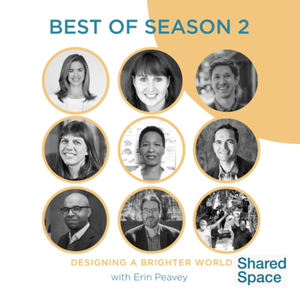
10/06/21 • 40 min
In this special Best Of Shared Space Season 2! We talk with architects, psychologist, designers, activists, writers, urban planners – a host of amazing community changemakers on season two and we weave all of those together for you all. We start with a basic understanding of what is loneliness, social health, and social capital and why is it so important? Then we dive into office spaces, public places, housing, and more – exploring examples from across the globe as to what types of design strategies and approaches foster health, happiness, social connection and combat loneliness.
Interviews
Dr. Mario Luis Small, sociologist, endowed professor at Harvard University, and Panama native - shares his studies on social networks, and starts by defining a key component of our social health – social capital, and why it is critical for so many of the other social determinants we think of from transportation, education and habit formation.
Nigel Oseland, author and environmental psychologist – shares findings from his recent book Beyond The Workplace Zoo: Humanizing the Office. He specializes in workplace design for human connection, and I was honored to be his first interview for his new book.
Emily Anthes, New York Times reporter and author shares findings from her book – The Great Indoors: The Surprising Science of How Buildings Shape Our Behavior, Health, and Happiness.
Mitchell Reardon, urban planner with Happy Cities – talks about what it means to create truly accessible spaces for everyone, where everyone feels welcome. He shares fascinating research findings around Streets for People, a study they did in Canada at the beginning of the Pandemic.
Katie Swenson, design activist and author of MASS Design Group just published two books – Design with Love: At Home in America about her time with Enterprise Communities, and In Bohemia about her personal journey. She discussed how architecture needs to rethink and evaluate the success of spaces and the importance of dignity in design as a fundamental need.
Shelby Blessing, Architect and Activist in Austin Texas shares her experiences working with the Community First Village in Austin – designed specifically for community building and connection for formerly homeless individuals.
June Grant, Okland based activist and architect shares her experiences working with AARP – the largest non-profit dedicated to older adults to create a guidebook for Accessory Dwelling Units – as a method for maintaining community fabric and fostering social connection in communities.
Andrew Howard, urban planner with Team Better Block and WGI talks about what is really important about not only the product but the process of community design.
Judy Sullivan and Meg Moschetto from the Cochrane Heights Neighborhood Association in Dallas, Texas share their perspective of citizen activists that transformed a rundown empty space into a vibrant public community space. They share what it took to get it done and what it changed for their neighborhood community.
...
About the Host:
Erin is an architect and design researcher bridging the gap between research and practice with a focus on design for health.
Website: www.erinpeavey.com
Twitter: @erin_peavey
Instagram: @design.for.health
Show more best episodes

Show more best episodes
Featured in these lists
FAQ
How many episodes does Shared Space have?
Shared Space currently has 34 episodes available.
What topics does Shared Space cover?
The podcast is about Design, Podcasts and Arts.
What is the most popular episode on Shared Space?
The episode title 'Building Connection, One Alley at a Time' is the most popular.
What is the average episode length on Shared Space?
The average episode length on Shared Space is 31 minutes.
How often are episodes of Shared Space released?
Episodes of Shared Space are typically released every 14 days.
When was the first episode of Shared Space?
The first episode of Shared Space was released on Jun 7, 2020.
Show more FAQ

Show more FAQ
